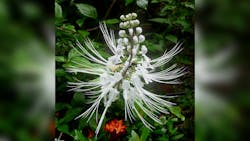There have been some interesting announcements and publications regarding horticultural solid-state lighting (SSL) and agricultural technology (AgTech) research & development and education. While we don’t have as much time as we would like to report on these individually, a quick “download” is time worth spending.
LEDs increase bioactive herbal compounds
Monash University Malaysia has published an article featuring work by associate professor Lim Yau Yan and colleagues researching bioactive compounds in various herbs used in products from herbal medicines to nutraceuticals to skincare and cosmetics. As part of their work, the scientists experimented with LED lighting impacts on the yield of a compound called rosmarinic acid, which has anti-inflammatory and antioxidant properties, and can be used in preservatives. In a growth chamber on the university campus, researchers utilized tunable SSL with varying spectral composition and found that a mix of about 50% red light and 25% blue light increased the yield of rosmarinic acid in a plant called misai kucing (cat’s whiskers, seen in the photo above), part of the Lamiaceae family. You can learn more about the studies from the Monash University website.
GLASE/Cornell teams study hemp under supplemental lighting
With the New York market for industrial hemp growing to about 9 million ft2 produced in 2020, Cornell University has established the Cornell Hemp Research Team that includes professor Neil Mattson, who delivered the keynote at our HortiCann Light + Tech conference in 2019. Mattson is also a principal investigator for hemp studies at the Greenhouse Lighting and Systems Engineering (GLASE) consortium. Mattson designed studies to determine the effects of various light treatments — including high-pressure sodium, metal halide, and LED lighting — on hemp plant growth characteristics and differences in cannabidiol (CBD) and tetrahydrocannabinol (THC) concentrations in the flowers produced. Mattson is also looking into the economic feasibility of greenhouse growing of hemp plants beyond the transplant stage, which could help mitigate pest or plant pathogen risks. Learn more at the GLASE website.
GE Current and WUR team up for SSL guidance
As we have reported previously, GE Current (a Daintree company) has been active in horticultural SSL research and controlled environment agriculture (CEA) projects for some time. But even so, the company and its latest research partners at Wageningen University and Research (WUR) in the Netherlands have commented that horticultural lighting can still seem complex and difficult to implement. Thus, they have joined together to develop rigorous studies on interlighting with GE Current’s LED-based fixtures compared to HPS for supplemental lighting in greenhouses. The company looks to combine its knowledge of SSL product design with WUR’s expertise in CEA research to aid growers in better understanding the qualities of HPS and LED, and how toplighting and intra-canopy lighting produce different results.
IPH program drives crop protection with ‘Dragon’
Funded by the New York Farm Viability Institute (NYFVI), the Illumination for Plant Health (IPH) program at Rensselaer Polytechnic Institute’s Lighting Research Center (LRC) recently made available instructions for farmers to build their own mobile ultraviolet (UV) device that attaches to a tractor as a way to manage pests and plant diseases in agricultural applications. UV-C lamps that produce 254-nm radiation have been shown to reduce the incidence of powdery mildew, and possibly other crop-degrading pathogens and insect activity. The IPH team has provided what appears to be an excellent overview on its “Dragon” mobile UV-C array, and detailed guidance for components, materials, construction, and safe operation. Interested parties can get more information and access downloads from the IPH news update.
For up-to-the-minute LED and SSL updates, why not follow us on Twitter? You’ll find curated content and commentary, as well as information on industry events, webcasts, and surveys on our LinkedIn Company Page and our Facebook page.

Carrie Meadows | Editor-in-Chief, LEDs Magazine
Carrie Meadows has more than 20 years of experience in the publishing and media industry. She worked with the PennWell Technology Group for more than 17 years, having been part of the editorial staff at Solid State Technology, Microlithography World, Lightwave, Portable Design, CleanRooms, Laser Focus World, and Vision Systems Design before the group was acquired by current parent company Endeavor Business Media.
Meadows has received finalist recognition for LEDs Magazine in the FOLIO Eddie Awards, and has volunteered as a judge on several B2B editorial awards committees. She received a BA in English literature from Saint Anselm College, and earned thesis honors in the college's Geisel Library. Without the patience to sit down and write a book of her own, she has gladly undertaken the role of editor for the writings of friends and family.
Meadows enjoys living in the beautiful but sometimes unpredictable four seasons of the New England region, volunteering with an animal shelter, reading (of course), and walking with friends and extended "dog family" in her spare time.





